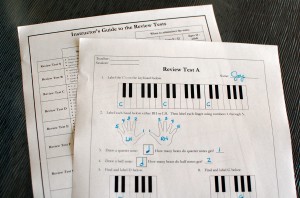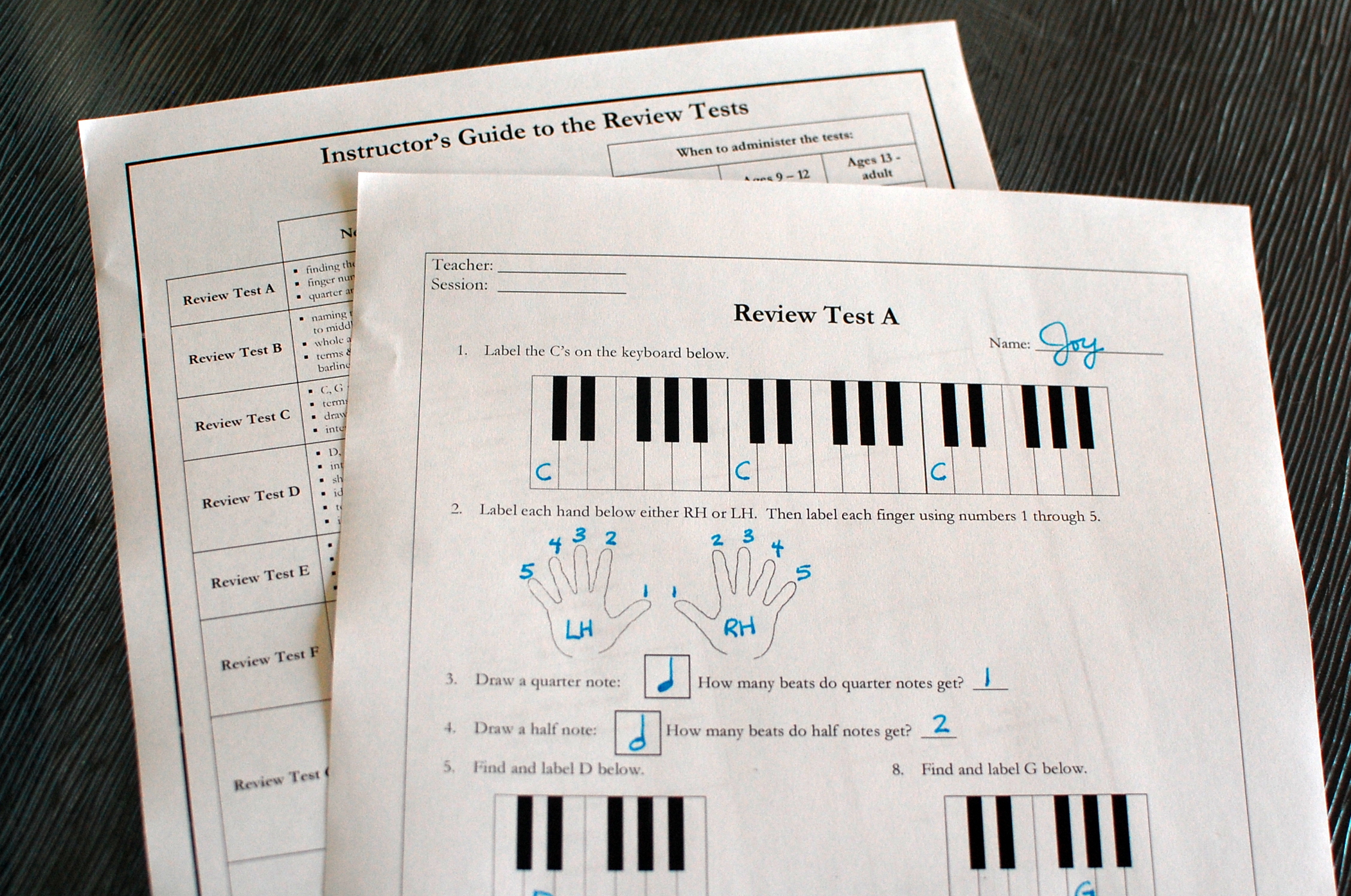 If you navigate over to the Printables > Worksheets area, you will find some new worksheets listed. This set of Review Tests was originally created for group keyboard classes of various age groups, but they may easily be adapted for other uses. The set is basically a set of progressive worksheets testing in the areas of basic piano skills and music theory. They may work well for group lessons, or just for single students to brush up on their theory skills.
If you navigate over to the Printables > Worksheets area, you will find some new worksheets listed. This set of Review Tests was originally created for group keyboard classes of various age groups, but they may easily be adapted for other uses. The set is basically a set of progressive worksheets testing in the areas of basic piano skills and music theory. They may work well for group lessons, or just for single students to brush up on their theory skills.
- Review Test *GUIDE* — This chart provides the teacher an easy guide for what concepts must be introduced to the student in order for them to successfully complete each Review Test on their own.
Concepts covered in each worksheet:
- Review Test A — finding the keys A – G on the piano; finger numbers; quarter and half notes.
- Review Test B — naming notes on the staff (treble clef: middle C to G; bass clef: F to middle C); whole and dotted half notes; terms & symbols: treble clef, bass clef, staff, barline, double barline, repeat sign, forte, piano.
- Review Test C — C, G major 5FPs (five-finger patterns); terms: slur, staccato, accents; drawing barlines in rhythms in 3/4 and 4/4 time; intervals: unison, 2nd, and 3rd.
- Review Test D — D, A, F major 5FPs; intervals: unison, 2nd, 3rd, 4th, and 5th; sharps, flats, and naturals; identifying all notes on the staff (with accidentals); terms: forte, mezzo forte, mezzo piano, piano, ritardando; identifying rhythms in 2/4, 3/4, and 4/4 time.
- Review Test E — E, B, Bb major 5FPs; major triads and arpeggios: root, 3rd, and 5th; Review: drawing barlines in 3/4 and 4/4 time rhythms; identifying major versus minor 5FPs and arpeggios by ear.
- Review Test F — Eb, Ab, Db, C# major 5FPs; terms: pianissimo, fortissimo, crescendo, descrescendo; Review: piano, mezzo piano, mezzo forte, forte; writing C & G 5FPs on the staff; Review: drawing barlines in 3/4 and 4/4 time rhythms; identifying question and answer phrases by ear.
- Review Test G — Gb, F#, Db, Cb major 5FPs (review B and C#); enharmonic 5FPs; writing the D major and D minor 5FPs on the staff; pattern for minor 5FPs: WHWW; which note changes in the 5FP when going from major to minor: the 3rd note goes down a half step; naming major and minor triads; Review: all major 5FPs; identifying major versus minor triads by ear.
- Review Test H — C, G, D, A major scales; pattern for major scales: WWHWWWH; order of sharps; fingering for white key major scales (besides F major); intervals: unison, 2nd, 3rd, 4th, and 5th; naming major and minor triads; Review: naming major and minor 5FPs; identifying major versus minor melodies by ear.
- Review Test I — E, B, F, Bb, Eb, Ab major scales; order of flats; writing E, B, F, Bb, Eb, and Ab major scales on the staff; fingerings for the F and B major scales; intervals: unison, 2nd, 3rd, 4th, 5th, 6th, 7th, and octave; Review: naming major and minor triads; identifying intervals unison through fifth by ear.
- Review Test J — the circle of fifths; all major scales and key signatures; Review: order of flats and sharps; Review: intervals unison through octave; identifying the intervals unison through octave by ear; 6/8 time and 4/4 with sixteenth notes; writing Ab, Db, Gb, Cb, F#, and C# major scales on the staff.
To download the set of worksheets along with the Teacher’s Guide, visit the Printables > Worksheets and scroll down to the M’s for “Music Theory Review Tests plus Teacher’s Guide.” I hope you find these worksheets to be useful!



I love your website, which I just ran across last night. However, I can’t open any of the worksheet links. Help! 🙂 Thanks!
Thanks, Kelby. I have been having difficulty with the plugin I was using to organize my printable files — but it has all been re-done as of 10/27/09! I hope those links don’t give you (or me) any more trouble. =]
Thanks for visiting!
Please help explain the names of the flat majors.How is B flat an F major or D minor . Example: I understand F sharp is G major because it goes up and E minor goes down but I fail to understand B flat is F major or D minor. Can you PLEASE help me?
The location of the sharps/flats within the scale doesn’t necessarily correspond to what key you are in. For a full explanation, try reading this article or watching this circle of fifths video lesson.